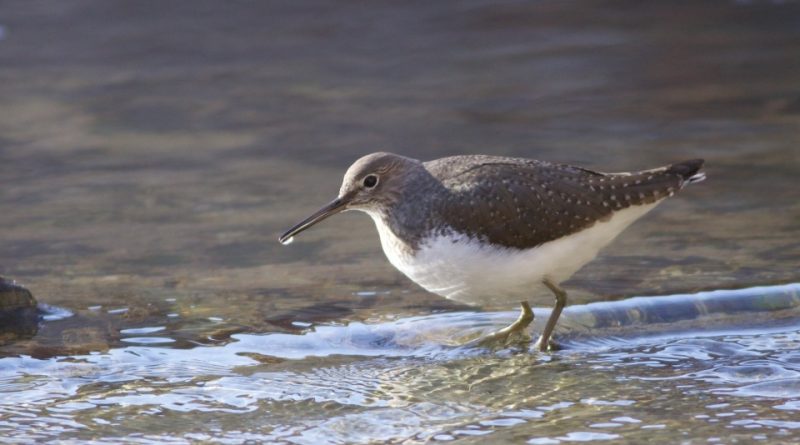Tringa ochropus
Tringa ochropus
The Green sandpiper (Tringa ochropus, Linnaeus 1758) is a bird belonging to the Scolopacidae family.
Systematics –
From a systematic point of view it belongs to:
Domain Eukarya,
Kingdom Animalia,
Subkingdom Eumetazoa,
Superphylum Deuterostomia,
Phylum Chordata,
Subphylum Vertebrata,
Infraphylum Gnathostomata,
Superclass Tetrapoda,
Aves class,
Order Charadriiformes,
Suborder Piarist,
family Scolopacidae,
Genus Tringa,
Species T. ochropus.
The terms are synonyms:
– Helodromus ochropus (Linnaeus, 1758);
– Rhyacophilus ochropus (Linnaeus, 1758);
– Totanus ochropus (Linnaeus, 1758).
It is a monotypic species and no subspecies are recognised.
Geographic Distribution and Habitat –
Tringa ochropus is a bird that breeds in subarctic Europe and east in the Palaearctic and is a migratory bird, wintering in southern Europe, the Indian subcontinent, Southeast Asia and tropical Africa.
Its distribution area includes: all of Africa, Asia and Europe, and in Alaska. It is accidental on African islands (Seychelles, Madagascar, Saint Helena, etc.), in Botswana and in Western Sahara, in Australia, Iceland and on the Faroe Islands.
Its habitat is that of the river banks and the vicinity of watercourses and also in marshes, lagoons, sometimes also on the coasts.
Description –
The Tringa ochropus is a rather chubby little wader with a length of 21-23,5 cm and a wingspan of 43-47 cm and more, without sexual dimorphism.
The beak is short (cm. 3,3 – 3,5cm), furthermore the neck is slender and elegant, with a candid white overtail and dark brown axillary feathers, streaked with white.
The head is very dark, blackish, clearly contrasting with the paler throat.
All the rachis of the remiges are dark, with white rectrices in the basal half, with 3-4 black transversal bands. The plumage has spring variations, with dorsal whitish speckles.
The back is white-spotted to varying degrees, with the greatest distribution in the breeding adult and least in winter and in young birds.
The legs and short beak are both dark green.
This bird is quite striking in flight, with dark wings above and below and a brilliant white rump. The latter feature reliably distinguishes it from the solitary Tringa.
In flight, it emits a distinctive chant as a sharp, loud whistle: “tu-hit, tu-hit, tu-hit” repeated obsessively and excitedly when fleeing potential danger.
Biology –
For its reproduction, the Tringa ochropus frequents the marshy and wooded areas near ponds, rivers and lakes with muddy banks, while during the migration and in the wintering areas it settles in the inland and coastal freshwater wetlands, such as banks of rivers and lakes, water meadows, rice fields, temporarily flooded areas. Occasionally it stops in brackish wetlands and rarely along the sea coasts.
The reproductive season goes from mid-April to June and in the year it produces only one brood.
The courtship that precedes the mating sees this wader performing the so-called cricket jump: one of the partners stands behind the other with the tail open like a fan and the wings raised and then flies above it.
Furthermore, this bird often uses the abandoned nest of other species of birds or squirrels.
Here she lays 2-4 eggs and the brood takes about three weeks to hatch.
Ecological role –
The Tringa ochropus is a bird that lives as solitary specimens throughout the year even if sometimes it happens to see 3-4 individuals together.
It is easily identifiable above all due to its habit of frequenting open environments, even if sometimes, in particular when it stops on canals and ditches, it can be more difficult to detect; however it tends to behave like a shy bird, prone to hiding and silent.
This species was formally described by the Swedish naturalist Carl Linnaeus in 1758 in the tenth edition of his Sistema Naturae with the current binomial name Tringa ochropus.
The genus name Tringa is from the Ancient Greek trungas, a wading bird the size of a thrush, white-rumped, with wagging tail, mentioned by Aristotle. The specific term ochropus comes from the ancient Greek okhros, “ochre”, and pous, “foot”.
This bird mainly feeds on invertebrates associated with humid or marshy environments or with soft soils rich in organic substance. The food consists of small invertebrates collected from the mud, such as molluscs, crustaceans, worms, insects and vegetables, while this species works constantly around the edges of the chosen wetland.
As regards its state of conservation, it is a widely distributed and not rare species; thus it is not considered a threatened species by the IUCN on a global scale. It is one of the species to which the Agreement on the Conservation of Afro-Eurasian Migratory Waterbirds (AEWA) applies.
Guido Bissanti
Sources
– Wikipedia, the free encyclopedia.
– GBIF, the Global Biodiversity Information Facility.
– C.Battisti, D. Taffon, F. Giucca, 2008. Atlas of nesting birds, Gangemi Editore, Rome.
– L. Svensson, K.Mullarney, D. Zetterstrom, 1999. Guide to Birds of Europe, North Africa and the Near East, Harper Collins Publisher, UK.
Photo source:
– https://inaturalist-open-data.s3.amazonaws.com/photos/252072781/original.jpeg


